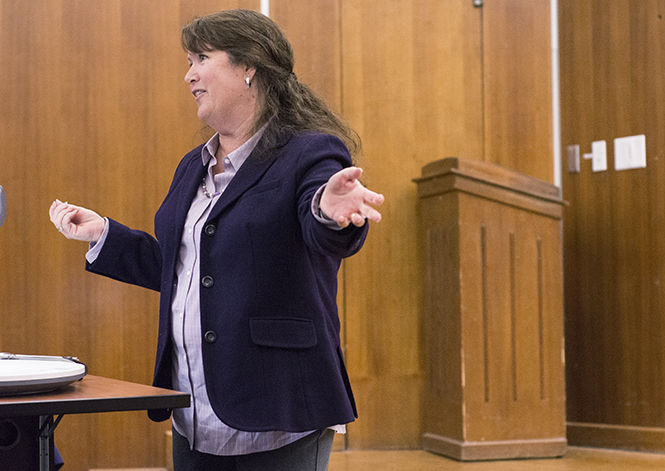Archaeologist presents ancient Greek discoveries
University of California, Berkley professor Kim Shelton speaks on Thursday, Nov. 13, 2014 in Bowman Hall about her archeological dig at the Petsas House in ancient Mycenae, modern day Greece, and the artifacts discovered at the site.
November 14, 2014
The ancient Greek archaeology site of Mycenae was the topic of discussion Thursday night.
The speaker, Kim Shelton, is part of a national lecture circuit sponsored by the Archaeological Institute of America. Shelton serves as associate professor and director of the Nemea Center for Classical Archaeology at the University of California, Berkeley.
The presentation, hosted by the Department of Modern and Classical Languages on Nov. 13, “Pottery, Paintings and Pinakides: the latest dirt from Petsas House, Mycenae,” focused on Shelton’s findings at the 14th century B.C. Petsas House.
Shelton said the Petsas House is from the late Bronze Age. A farmer discovered the site in the 1950s when he unearthed a large vase. Shelton started working on the house in 2000.
She told the audience her team discovered approximately 12,000 ceramic vases in the house. It appeared to be a combination of a house and a pottery factory, she said. Shelton estimates that her team excavated two-thirds of the house.
“We still haven’t found the entire structure, but I think we have a good sense of it,” Shelton said.
Shelton displayed her findings and explained each room she helped excavate. She said the complexity of the house is not uncommon.
“You hardly ever find just a house,” she said.
Shelton said the house included a well, pottery storage and manufacturing rooms.
Junior classics major Jen Novak attended the event to learn more about Greek archaeological sites.
“I’ve mostly spent time studying Roman sites,” Novak said. “Greek sites are really similar in a lot of ways. It was cool to see the similarities and the differences from someone who’s worked firsthand.”
Junior English major Michael Minnillo attended the event after hearing about it in his Latin class.
“I thought it was fascinating,” Minnillo said. “This is the first presentation I’ve been to of this kind.”
Contact Erica Batyko at [email protected].

























